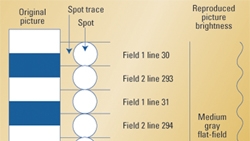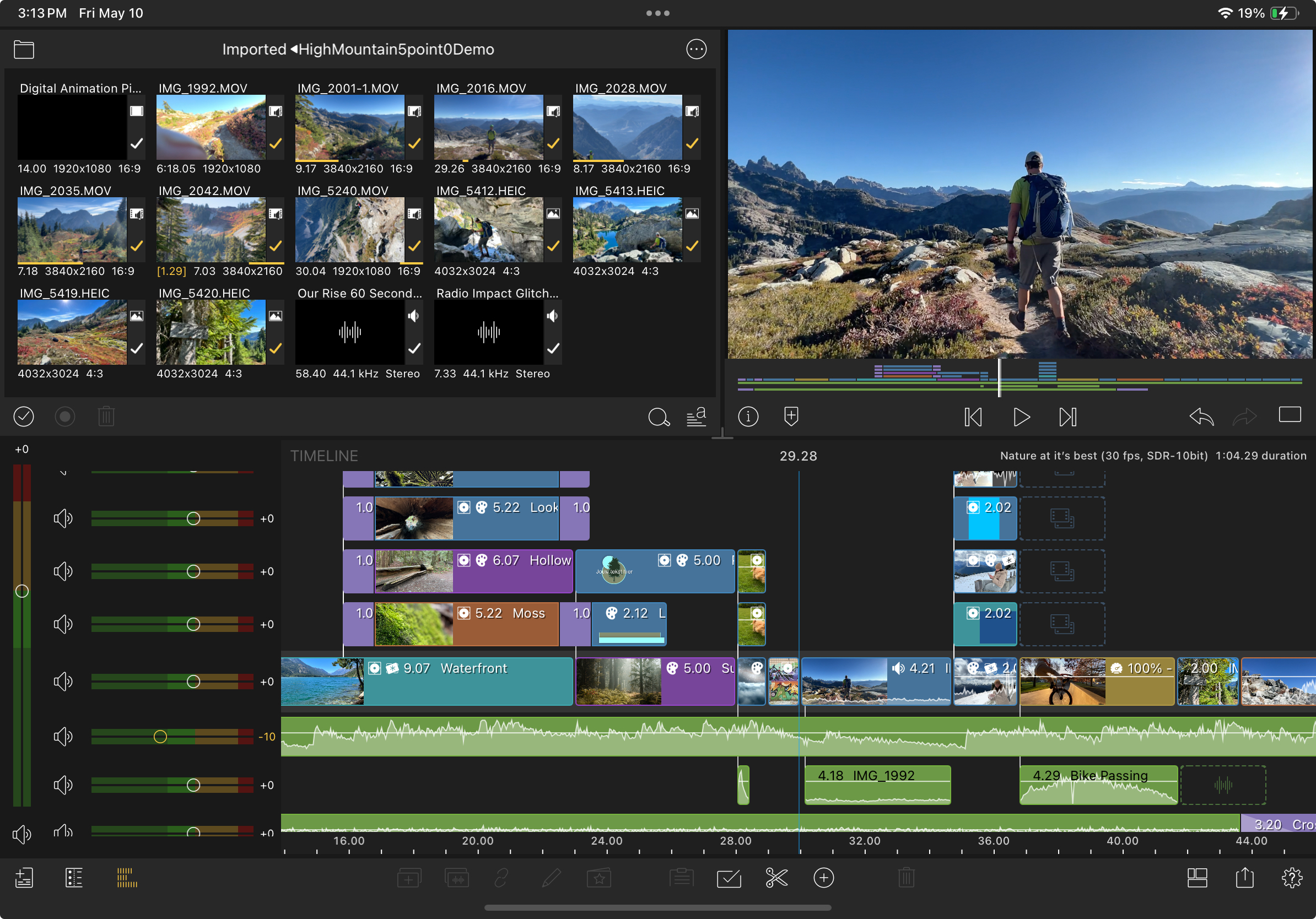Video resolution: The analog concept

The extent to which a picture medium such as television can reproduce fine detail is expressed in terms of resolution. The early development of television resulted in the two dominant SDTV scanning formats, the 525/60 and the 625/50. The aim was to achieve a satisfactory picture, taking as a reference the visual acuity of the eye. The human visual system (HVS) has two main resolution characteristics: namely, the spatial resolution and the temporal resolution.
Figure 1. When scanning lines straddle picture details, vertical resolution is diminished. Click here to view an enlarged image.
The spatial resolution
Television system design takes as a reference the visual acuity of the eye, which is of the order of one minute of arc. Picture details that subtend an angle of less than one minute of arc are not perceived by the eye. The assumption was made that the picture would be viewed at distance of approximately six times the screen height. So a decision had to be made as to the number of lines should make up a picture. Too many lines would be a waste and too few lines would make the raster line structure visible. North America chose 525 lines and Europe chose 625 lines. The number of visible (active) lines (NAL) is smaller to allow for the vertical retrace of the scanning spot. So in North America we have NAL ˜ 485 and in the rest of the world NAL = 575. A complete picture (frame) is made up of two consecutive fields, each containing half of the total number of lines (262.5 and 312.5). The lines in two consecutive fields are interlaced, resulting in a frame made up of the total amount of lines (525 or 625).
The vertical resolution
The vertical resolution is independent of the video bandwidth and equals the number of alternately white and black horizontal lines (NV) that can be resolved vertically over the full height of the picture. It is expressed in lines per picture height (LPH). The early developers of television in the 1930s determined that the vertical resolution is statistically equal to 70 percent of the number of active lines. The so-called “Kell Factor” of 0.7 is at the origin of all conventional television systems.
In the 525/60 scanning standard
Get the TV Tech Newsletter
The professional video industry's #1 source for news, trends and product and tech information. Sign up below.
NV = 0.7 × NAL = 339.5LPH, so let's round it down to 339LPH.
If the vertical details in the picture exceed 339LPH they are blurred. In the 625/50 scanning standard
NV = 0.7 × NAL ˜ 402LPH.
Figure 1 shows the case of scanning lines straddling picture details. The result is a loss of vertical resolution.
The horizontal resolution
The aim is to achieve an equal number of picture elements per unit of distance, i.e the picture height, horizontally as well as vertically. Figure 2 shows the formation of a sine wave resulting from scanning horizontally aligned picture elements, in this case alternately white and black. The system must allow for a number of horizontal picture elements (Hpix) that is equal to the NV multiplied by the image aspect ratio (IAR). In the 525/60 SDTV format IAR = 4/3 and NV = 339 so:
Hpix = 339LPH × (4/3) = 452 pixels.
This results in 452/2 = 226 complete cycles during the active horizontal scanning line.
Given an active line duration of 52.85µs, this results in a cycle duration of:
T = 52.85µs/226 = 0.2338µs.
The associated frequency is:
F = 1/T = 1/0.2338µs ˜ 4.28MHz.
This is the bandwidth required to achieve equal horizontal and vertical resolution. The horizontal resolution factor for a 4.28MHz bandwidth is
339LPH/4.28MHz = 79.2 lines/MHz
Given that the transmitted bandwidth is 4.2MHz, the transmitted horizontal resolution is reduced to:
NH = 4.2MHz × 79.2 lines/MHz ˜ 333LPH
Figure 2. This diagram shows the relationship between horizontal pixels and the corresponding electrical signal in a TV system. Click here to view an enlarged diagram.
In the 625/50 scanning standard the minimum video bandwidth for equal horizontal and vertical resolution is 5.15MHz, and the resulting horizontal resolution factor is 78 lines/MHz. Various countries have adopted different maximum transmitted baseband video frequency values, resulting in different horizontal resolutions. In the dominant 625/50 transmission standard (CCIR B,G) the maximum transmitted baseband video frequency is 5MHz, resulting in a transmitted horizontal resolution of:
NH = 5MHz × 78 lines/MHz = 390LPH.
Reducing this bandwidth reduces the horizontal resolution. A 2MHz luminance bandwidth, typical of VHS, would result in a horizontal resolution of about 160LPH without affecting the vertical resolution.
NTSC and PAL composite signal encoding formats have a typical color difference (B-Y ad R-Y) bandwidth on the order of 600kHz with a resulting horizontal resolution of around 48LPH. The chrominance vertical resolution is unaffected in NTSC but is reduced to half that of the luminance component in PAL due to the line-sequential V subcarrier phase alternation.
Using the same analog approach as above, let's calculate the parameters of the HDTV 1125/60 format. In this format the number of interlaced lines per frame is 1125/60 and the number of active lines per frame is 1080. Given a Kell factor of 0.7, the effective vertical resolution is:
NV = 0.7 × 1080 = 756LPH.
In the 1125/60 HDTV format, NV = 756 and IAR = 16/9, so
Hpix = 756 × (16/9) = 1344.
This results in 1344/2 = 672 complete cycles during the active horizontal scanning line. In the 1125/60 scanning standard the total line duration is 29.6µs and the active line duration is 25.83µs. This results in a single cycle duration of:
T = 25.83µs/672 = 38.43ns.
The associated frequency is:
F = 1/T = 1/38.43ns = 26MHz.
This is the transmission bandwidth required for equal horizontal and vertical resolution of the Y component of the 1125/60 interlaced HDTV system. The horizontal resolution factor for a 26MHz bandwidth is:
756LPH/(26MHz) = 29 lines/MHz.
The temporal resolution
Figure 3. Vertical resolution equals number of active lines when the raster lines are centered on the picture details. Click here to view an enlarged diagram.
An important property of the eye is the persistence of vision, or the ability of the viewer to retain or in some manner remember the impression of an image after it has been withdrawn from view. When light entering the eye is shut off, the impression of light persists for about 0.1 sec. Ten still pictures per second is an adequate rate to convey the illusion of motion. Reducing flicker, however, requires still higher picture rates. Given the transmission spectrum conservation requirements that imposed a 6MHz channel bandwidth (7- or 8MHz in Europe), the early television developers adopted the interlaced scanning concept, where a picture is divided in two consecutive fields transmitted at a frequency of (nominally) 60Hz (50Hz in Europe). This allowed for the reduction of the transmission bandwidth requirements. The result is that large areas of uniform color and brightness flicker at the field rate (60Hz or 50Hz large area flicker), and this is acceptable. If two adjacent lines in two consecutive fields are not identical, as shown in Figure 3, the result is interline flicker at the frame rate (30Hz or 25Hz). Interline flicker is tolerable because the eye is relatively insensitive to flicker when the variation of brightness is confined to a small part of the field of view. The method works well when the picture is stationary. When there is movement, the two consecutive fields may not be equal and “movement judder” results. Progressive scanning requires a wider bandwidth but does not suffer from small area flicker and judder. In the October issue we will discuss the digital resolution concept.
Michael Robin, former engineer with the Canadian Broadcasting Corp.'s engineering headquarters, is an independent broadcast consultant located in Montreal, Canada. He is co-author of Digital Television Fundamentals, published by McGraw-Hill.
Home |Back to the top|Write us
Send questions and comments to:michael_robin@primediabusiness.com
